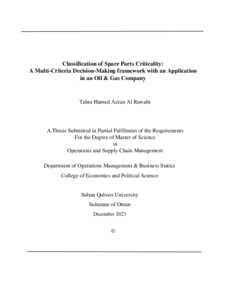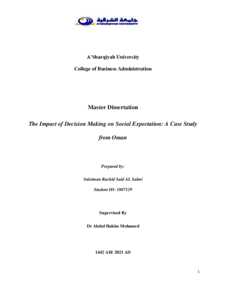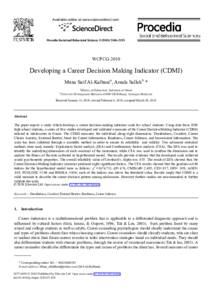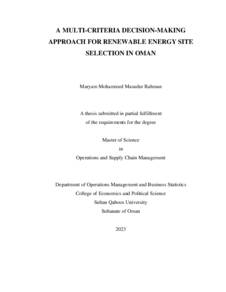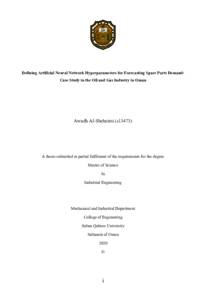Document
Classification of spare parts criticality : a multi-criteria decision-making framework with an application in an Oil & Gas Company.
Source
Master's thesis
Other titles
تطبيق الإطار متعدد المعايير لاتخاذ القرارلتصنيف أهمية قطع الغيار في شركة النفط والغاز
Country
Oman
City
Muscat
Publisher
Sultan Qaboos University
Gregorian
2023
Language
English
Thesis Type
Master's thesis
English abstract
Spare parts are inventoried items stored in warehouses for immediate response to demand
requirements of repair jobs and maintenance activities.
Most oil & gas companies maintain large numbers of spare parts to ensure stock availability and
avoid shortages. Due to the substantial contribution of spare parts to the total inventory cost, it is
important to balance stock availability and the inventory holding costs of spare parts. In line with
these objectives, the specification of the spare parts to keep in stock is one of the most crucial
steps which requires the spare parts to be classified based on the corresponding criticality.
Criticality is a key factor towards identifying the resources and the actions needed to reduce the
risk or the impact of failures and losses affecting a process, including incidents relating to
economy, safety, and environment, among other practical aspects.
The aim of this thesis is to identify the most relevant criteria for the classification of spare parts
criticality prior to assessing their impact on inventory management using a large oil & gas
company in Oman as a case study, the
The investigations are based on a methodological framework that integrates two multi-criteria
decision-making (MCDM) techniques, namely, Evaluation based on Distance from Average
Solution (EDAS) and Ordered Weighted Averaging (OWA) operator.
The findings of this study reveal that less than 2.5% of the spare parts require special attention
regardless of the optimism level of the decision maker, which enables reducing substantially the
inventory costs besides assisting the inventory team in deciding what to maintain in stock and
whether to add or remove items from stock.
Arabic abstract
قطع الغيار هي أصناف معدة جردا مخزنة في مستودعات للاستجابة الفورية للاحتياجات المطلوبة من أعمال الاصالح وأنشطة الصيانة. وتحتفظ معظم شركات النفط والغاز بأعداد كبيرة من قطع الغيار لضمان توافر المخزون وتجنب حالات النقص. وبالنظر إلى المساهمة الكبيرة لقطع الغيار في مجموع تكلفة المخزون، فإنه من المهم تحقيق التوازن بين توافر المخزون وتكاليف مخزون قطع الغيار. وتماشيا مع هذه الاهداف، فإن تحديد قطع الغيار التي ينبغي الاحتفاظ بها في المخزون يُعد واحدًا من أهم الخطوات، الامر الذي يتطلب تصنيف قطع الغيار على أساس درجة أهميتها. وتمثل الاهمية الحيوية عامًلا رئيسياً في تحديد الموارد والاجراءات اللازمة للحد من مخاطر أو أثر الاخفاقات والخسائر التي تؤثر على عملية ما، بما في ذلك الحوادث المتصلة بالاقتصاد والسلامة والبيئة، ضمن جوانب عملية أخرى. وتهدف هذه الاطروحة المطبقة في إحدى شركات النفط والغاز في ُعمان )دراسة حالة( إلى تحديد أهم المعايير لتصنيف أهمية قطع الغيار قبل تقييم أثرها على إدارة المخزون . وتستند التحقيقات إلى إطار منهجي يجمع بين تقنيتين متعددتي المعايير لصنع القرار، هما التقييم القائم على أساس البعد عن متوسط الحل ومشغل المتوسط المرجح . وتكشف نتائج هذه الدراسة أن أقل من 2.5 في المائة من قطع الغيار تتطلب اهتما ًما خا ًصا بغض النظر عن التوقعات الايجابية لصناع القرار والذي قد يُسهم في خفض تكاليف المخزون إلى حد كبير إلى جانب مساعدة فريق الجرد في تقرير ما ينبغي الاحتفاظ به في المخزون وما إذا كان ينبغي إضافة أو إزالة مواد معينة من المخزون.
Category
Theses and Dissertations

